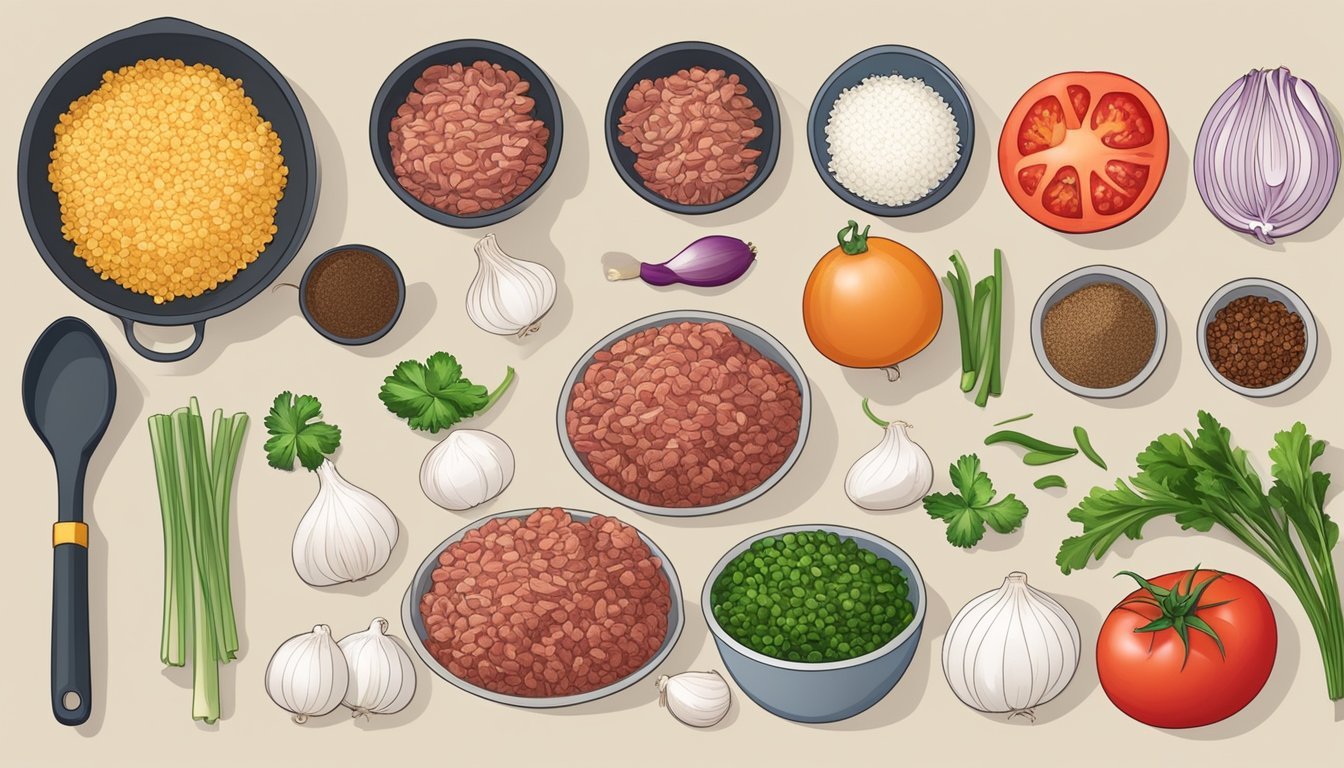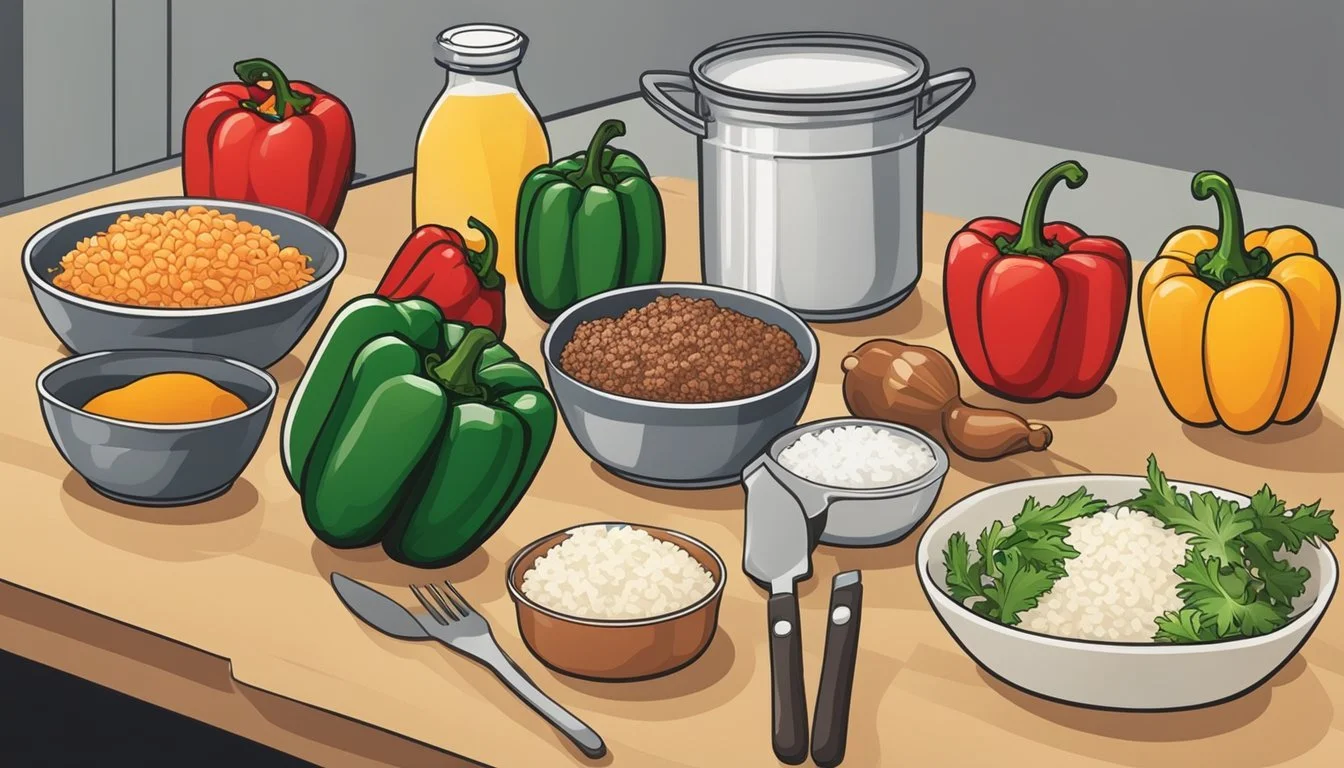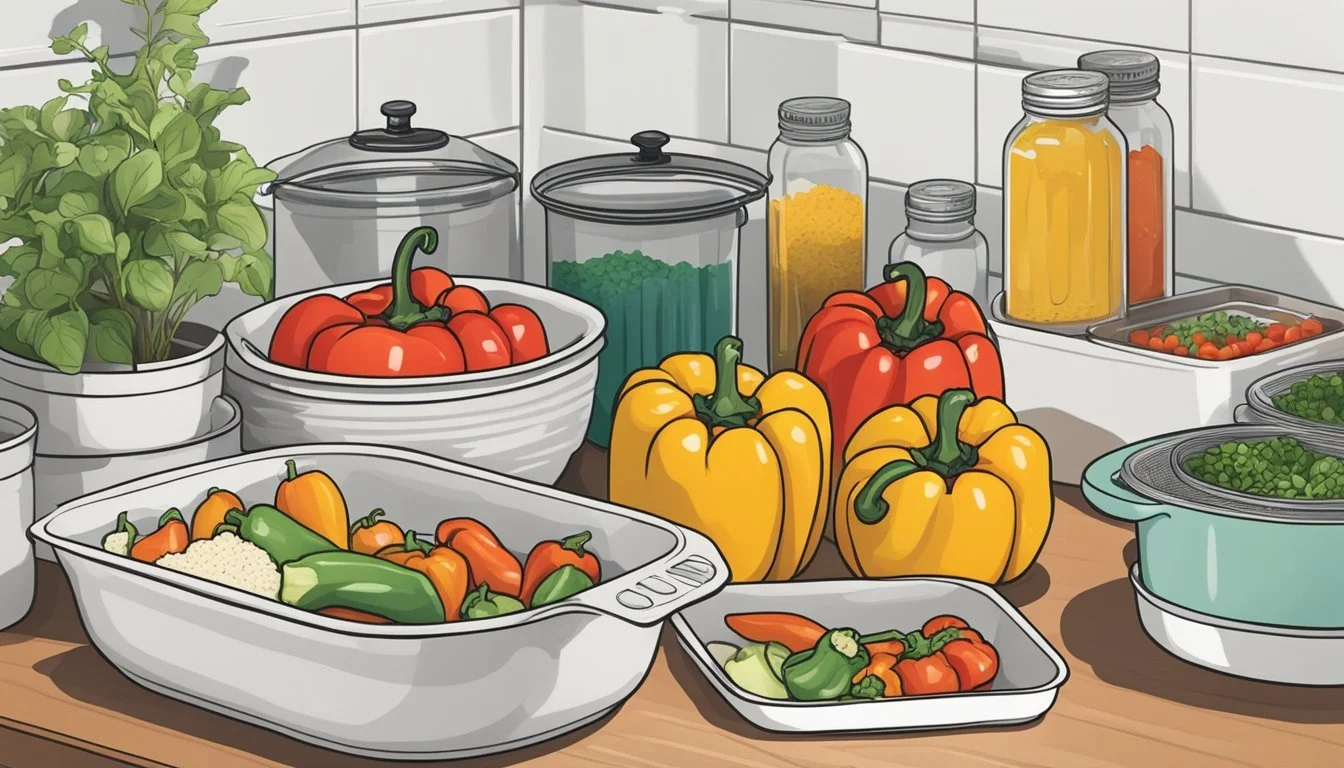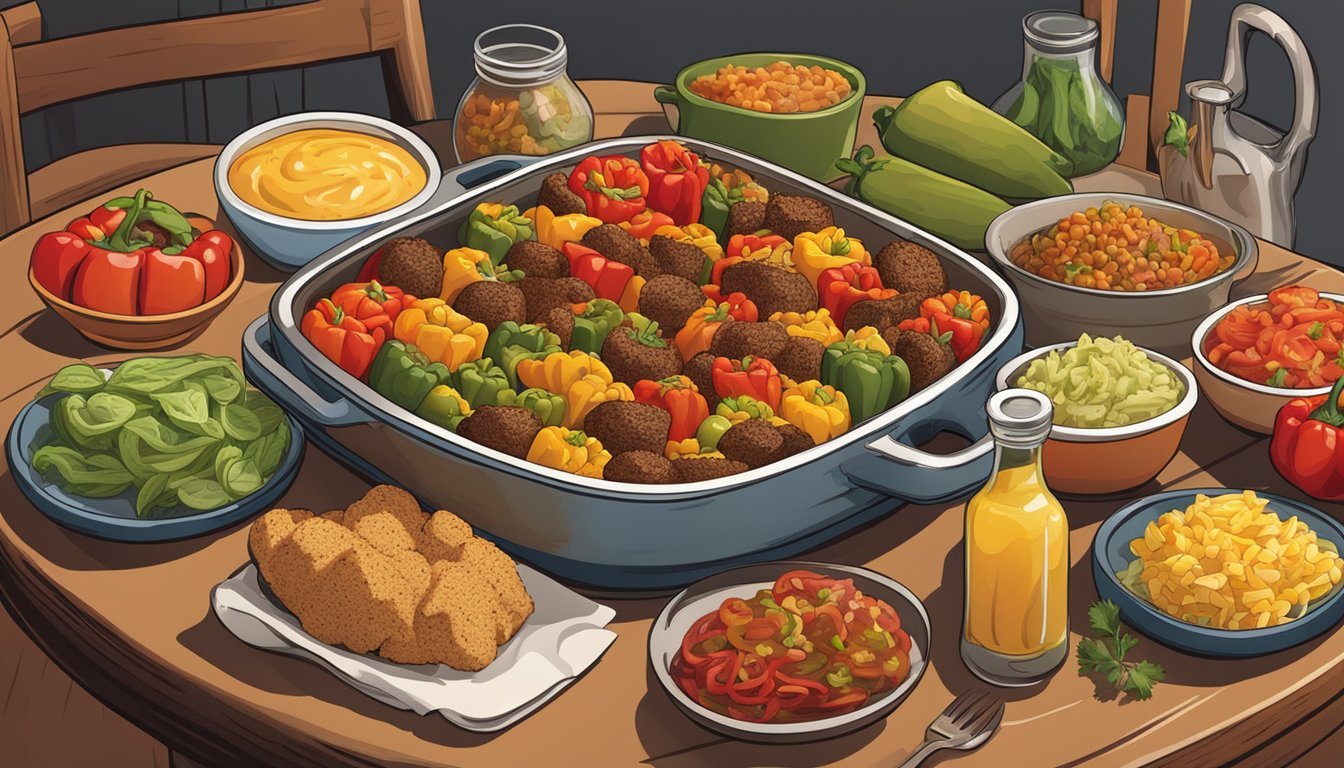How to Make Texas-Style Stuffed Peppers
A Step-by-Step Guide
Texas-style stuffed peppers bring a hearty, comforting flavor to the table with a kick of southwestern spice. Stuffed peppers in Texas often take on the robust tastes of the region, incorporating elements like smoked paprika, black beans, corn, and a blend of cheeses to create a dish that's as filling as it is flavorful. They provide an excellent canvas for various fillings and can be tailored to include a range of proteins, from ground beef to shredded chicken, ensuring that each pepper is brimming with taste.
The method for preparing these southwestern delights involves a few key steps to ensure the peppers are perfectly cooked and the filling is rich and satisfying. Bell peppers are chosen for their sweet, mild flavor and firm structure, capable of holding the generous stuffing without losing their shape. The use of spices like cumin, chili powder, and crushed red pepper is crucial for achieving that signature Texas taste – a balance of heat, smokiness, and depth. With the right ingredients and techniques, anyone can create this Texan favorite that stands out with its bold flavors and appetizing appearance.
Selecting Ingredients
Creating the perfect Texas-style stuffed pepper dish begins with the careful selection of quality ingredients. Choosing fresh produce, the right kind of protein, and flavorful cheese will ensure your stuffed peppers are delicious and authentic.
Choosing Bell Peppers
When selecting bell peppers, one should look for firm, vibrant peppers, which stand up well to stuffing and baking. Peppers should be even in color, without any wrinkles or soft spots. A mix of colors can be used, such as green, red, yellow, or orange bell peppers, to add visual appeal to the dish.
Types of Protein
A key ingredient in Texas-style stuffed peppers is protein. Common choices are:
Ground Beef: A classic option, providing a rich and savory flavor.
Ground Turkey: A leaner alternative that still delivers good texture and taste.
One should ensure that the protein chosen is fresh and of good quality for the best result in flavor and texture.
Opting for the Right Cheese
Cheese adds a creamy texture and a punch of flavor. For authentic Texas-style stuffed peppers, look for cheeses that melt well, such as:
Cheddar: A sharp taste that pairs well with beef.
Monterey Jack: Mild and creamy, perfect for complementing spices.
Cheese should be freshly grated for better melting and flavor distribution.
Preparing Additional Vegetables
The additional vegetables such as onion and garlic should be fresh and properly prepared. Onions should be firm and have a shiny outer layer, while garlic should be plump and without brown spots. These vegetables add depth and are typically sautéed to provide a flavorful base for the stuffing mixture.
Preparing the Filling
The key to a delicious Texas-style stuffed pepper is a flavorful and well-seasoned filling, featuring a hearty mix of protein, grains, vegetables, and a symphony of seasonings to capture that southwestern essence.
Cooking the Protein
For the base of the filling, one begins by cooking the protein choices thoroughly. Ground turkey or beef offers a classic choice, browned in a skillet over medium-high heat. It's essential the meat is cooked until there are no pink parts remaining, ensuring both flavor and safety.
Combining with Seasonings and Add-Ins
Once the protein is properly cooked, a bold Texan flavor profile is created by incorporating a variety of seasonings and add-ins. Taco seasoning, which typically includes components like cumin and chili powder, is mixed into the protein. Adding diced onions, which have been sautéed until translucent, enhances the depth of flavor further. For a touch of freshness and texture, corn and black beans are stirred in, complementing the protein and seasonings.
Including Rice for Texture
Finally, to round out the filling and provide a satisfying texture, cooked rice (how long does cooked rice last?) is folded into the mix. This additive not only stretches the filling to accommodate more peppers but also absorbs the flavors of the seasonings, enhancing the overall dining experience with every bite.
Assembling Stuffed Peppers
Assembling Texas-Style Stuffed Peppers involves stuffing the peppers with a flavorful filling, adding layers of cheese, and preparing them for baking to perfection.
Stuffing the Peppers
One begins by taking each washed bell pepper half and spooning the prepared filling generously into the cavity, pressing down slightly to ensure the mixture is well-packed. It's important that the peppers are stable; if necessary, a small slice can be trimmed from the bottoms to level them.
Layering Cheese
Once the peppers are stuffed, one sprinkles a generous amount of shredded cheese over the top of each pepper. The type of cheese used can vary, but traditional choices like cheddar or Monterey Jack complement the bold flavors commonly found in Texas-style dishes.
Preparing for the Oven
Each stuffed and cheese-topped pepper is then carefully placed in a greased baking dish. The dish should be large enough to accommodate the peppers without crowding them. To prevent the stuffed peppers from drying out during baking, it is advisable to cover the baking dish loosely with aluminum foil. The oven should be preheated according to the recipe's specified temperature, commonly at 350°F (175°C), and the peppers are baked until they're heated through and the cheese is melted and bubbly.
Cooking Methods
When making Texas-style stuffed peppers, the method of cooking is crucial for achieving the perfect balance of flavors and textures. The peppers can be prepared using an oven, grill, or a combination of microwave and stovetop techniques.
Baking in the Oven
For a classic approach, baking in the oven is the most traditional method. Preheat your oven to 350°F (175°C). Start by filling the deseeded peppers with your choice of seasoned meats and grains. Place them in a baking dish to ensure they remain upright during cooking. Typically, peppers need to bake for about 30-35 minutes, or until the peppers are tender and the filling reaches an internal temperature of 165°F (74°C).
Experimenting with Grill Cooking
Grilling your stuffed peppers introduces a smoky flavor that complements the Texan cuisine style. Preheat your grill to a medium-high setting and place the stuffed peppers directly on the grill grate or in a cast iron skillet for even cooking. Grill them covered for approximately 10-15 minutes, turning occasionally, until the peppers are charred and the fillings are hot and cooked through.
Utilizing Microwave and Stovetop
For a speedier cooking process, the microwave and stovetop can be utilized together. Begin cooking the stuffed peppers in the microwave for about 5-7 minutes to soften the flesh. Meanwhile, heat a stovetop pan, preferably a cast iron skillet, and transfer the microwaved peppers to the skillet. Cook them for a few minutes until the surface is seared and the filling is warmed through.
By understanding these different methods, cooks can choose the most suitable technique based on the texture they aim to achieve, the time they have available, and the equipment at their disposal.
Enhancing Flavor and Presentation
To create an exceptional Texas-style stuffed pepper dish, attention to flavor enhancement and visual appeal is crucial. Through the strategic use of garnishes and complementary side dishes, one can elevate both the taste and allure of the meal.
Applying Garnishes
In the realm of garnishes, one can add both visual flair and bursts of flavor to their stuffed peppers. A sprinkle of bold cilantro leaves provides a fresh and herby contrast, while dollops of sour cream introduce a creamy and cooling component. Adding slices of jalapeno contributes a spicy kick, which aficionados of heat will appreciate. An artistically arranged lime wedge allows diners to add a bright citrus zing according to their preference. Lastly, a spoonful of guacamole or salsa on the side or atop the peppers not only adds a vibrant color but involves a rich textural interaction and a fusion of tastes.
Serving with Side Dishes
When it comes to side dishes, they serve a dual purpose: complementing the main dish and enhancing its flavors. A well-chosen side dish should harmonize with the stuffed peppers, adding to the experience without overpowering it.
Side Dish Flavor Profile Complement to Stuffed Peppers Cilantro Lime Rice Zesty, Herbaceous The sharpness of lime and the greenness of cilantro marry well with the robust flavors of the peppers. Charro Beans Savory, Smoky Smoky beans offer a delightful contrast to the richness of the stuffing. Cornbread Sweet, Buttery A slice of moist cornbread adds a sweet complement to balance the spice.
By integrating these sides, the meal receives layers of texture and flavor, transforming it into a more rounded and satisfying dining experience.
Nutrition and Dietary Considerations
When preparing Texas-style stuffed peppers, one should be mindful of the nutritional content and accommodate various dietary needs. This includes being aware of calorie count, nutrition facts, and adapting recipes for dietary restrictions without compromising taste or authenticity.
Counting Calories and Nutrition Facts
Stuffed peppers can vary significantly in terms of calories and nutrition, largely based on the fillings used. Typically, a serving contains a balance of protein, carbohydrates, and vegetables. The beef used is a source of protein but also adds to the calorie count, which is a consideration for those monitoring their caloric intake. For a healthier option, one might choose leaner meats like ground turkey, or even a vegetarian substitute like quinoa, which still provides protein but with fewer calories. Here's a basic nutritional breakdown per serving:
Calories: Approximately 300-500
Protein: 15-20g
Carbohydrates: 30-50g
Fats: 10-20g
Rice and quinoa are common ingredients that contribute carbohydrates and should be measured accordingly.
Adapting Recipes for Dietary Restrictions
To address dietary restrictions, one can make several adaptations to the classic stuffed pepper recipe. Those requiring gluten-free options can ensure that all packaged products, like tomato paste or seasonings, are labeled gluten-free. For a healthy twist, brown rice or other whole grains can replace white rice for additional fiber and nutrients. By using olive oil instead of butter, the recipe can cater to those with dairy-free needs. Simple substitutions include:
Gluten-Free: Use gluten-free grains and check seasoning mixes.
Dairy-Free: Olive oil instead of butter, and omit cheeses or replace with dairy-free alternatives.
Vegetarian/Vegan: Substitute ground meat with beans, lentils, or textured vegetable protein.
Each ingredient should be selected with both nutrition and specific dietary needs in mind, ensuring the peppers are both delicious and appropriate for all guests.
Make-Ahead and Storage Tips
Texas-Style Stuffed Peppers are an excellent choice for a robust weeknight meal, and they adapt well to make-ahead preparations. With proper storage, leftovers can maintain flavor and texture.
Storing Leftovers
Leftover stuffed peppers should be stored in an air-tight container and placed in the refrigerator. They will keep well for up to 3 days. When storing, ensure the peppers have cooled to room temperature to prevent moisture buildup which can lead to sogginess.
Freezing and Reheating Instructions
Texas-Style Stuffed Peppers are also freezer-friendly, making them a convenient make-ahead option. To freeze, follow these steps:
Cool: Allow the peppers to cool completely before freezing to preserve texture.
Wrap: Individually wrap each pepper in plastic wrap to protect against freezer burn.
Container: Place the wrapped peppers in a freezer-safe bag or container. Label with the date to keep track of freshness.
Freeze: Stuffed peppers can be frozen for up to 2 months.
To reheat:
Thaw: For best results, thaw stuffed peppers in the refrigerator overnight.
Oven: Preheat the oven to 350°F (175°C). Remove the plastic wrap and place the peppers in a baking dish. Cover with foil to prevent drying.
Reheat: Warm the peppers for 20-30 minutes or until heated through. If desired, remove the foil during the last few minutes to allow the tops to slightly crisp.
By following these storage tips, one can ensure their Texas-Style Stuffed Peppers remain a delicious and convenient option for a future meal.
Customizing Your Stuffed Peppers
Customizing Texas-style stuffed peppers allows one to tailor the dish to personal tastes and dietary preferences. A variety of fillings and spices can transform the basic recipe into a signature dish that palate.
Alternative Filling Ideas
Texas-style stuffed peppers typically feature ground meat as their base. However, one can opt for ground turkey as a leaner alternative to beef or pork without sacrificing flavor. For a vegetarian twist, lentils serve as a nutritious and texture-rich substitute. Cheese is another key component, with cheddar, mozzarella, and pepper jack cheese offering distinct flavors and levels of creaminess. Incorporating fresh parsley not only adds color but also a fresh, herbal note to the filling.
Meat Options:
Traditional ground beef
Lean ground turkey
Chorizo for a spicy kick
Vegetarian Options:
Black beans or pinto beans
Cheese Varieties:
Sharp cheddar for a classic taste
Mild mozzarella for a creamy texture
Spicy pepper jack to amplify the heat
Herbs & Aromatics:
Fresh parsley
Diced onion and garlic sauté
Spicing Things Up
To elevate the flavor profile of Tex-Mex stuffed peppers, one can introduce various spices and sauces. A touch of cayenne pepper can sharply increase heat, while black pepper provides a more subtle warmth. For an authentic Tex-Mex experience, drizzling enchilada sauce over the top before baking infuses the peppers with a deep, tangy flavor.
Spice Levels:
Mild: a pinch of black pepper
Medium: a sprinkle of cayenne pepper
Hot: a generous amount of jalapeños or hot sauce
Sauces & Seasonings:
Enchilada sauce for smokiness and depth
Taco seasoning for that classic Tex-Mex blend
Salsa, either mild or hot, to moisten the filling and add a fresh kick
With these options, one has the freedom to create a dish that can be as unique as it is appetizing, all while staying true to the soul of Tex-Mex cuisine.
Pairing with the Perfect Side
When crafting a dinner menu featuring Texas-style stuffed peppers, one must consider sides that complement the bold flavors of the dish. Well-chosen sides can balance the meal, providing a complete and family-friendly dining experience.
Choosing Complementary Sides
For a Texas-style stuffed pepper dish, sides should add contrasting textures and flavors without competing with the main course's hearty profile. Here are some thoughtfully curated sides that pair beautifully with the peppers:
Skillet Cornbread: A Southern classic, its slight sweetness and moist texture are ideal for balancing spicier entrees.
Cilantro Lime Rice: The zesty lime and cilantro offer a refreshing palate cleanse between bites of savory peppers.
Garlic Green Beans: Lightly sautéed in olive oil, they add a crisp, healthful counterpart to the meal.
Buttermilk Coleslaw: Its cool creaminess can offset the robust and potentially spicy stuffing of the peppers.
Corn and Black Bean Salad: Add a salad that echoes some ingredients from the stuffed peppers, creating a consistent theme for the dinner.
Each of these dishes can be prepared in bulk, making them convenient for serving alongside the stuffed peppers at large family gatherings. They are not only delicious but also practical, keeping in mind the ease of preparation and serving.









